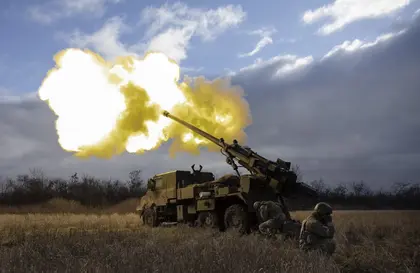France has pledged the production of 78 Caesar self-propelled 155mm howitzers for Ukraine over the course of the year, with the first batch of 6 delivered in the coming weeks.
“We are launching an initiative in artillery, the production of Caesar ACS from Nexter in Bourges and Roanne. Our initiative is aimed at producing 78 Caesars in 2024,” said Sébastien Lecornu, Minister of the French Armed Forces, in an interview with Le Parisien.
JOIN US ON TELEGRAM
Follow our coverage of the war on the @Kyivpost_official.
KMW+Nexter Defense Systems (KNDS), the Caesar’s manufacturer, said it had reorganized the production line and aimed to raise the production to 8 units per month by reducing the production time from 30 months to 16 months.
The production number is similar to the Ukrainian 2S22 Bohdana self-propelled howitzer built upon the Czech 8x8 chassis, which Ukraine aims to produce at a rate of around 72 systems per year.
The 155mm class is among the most powerful artillery systems fielded by Ukraine to destroy vehicle columns, strike ammo depots and break up armored attacks, and Caesar’s advanced fire control provides Ukraine with the ability to deliver a hard punch with pinpoint accuracy if needed.
The pledged number is also a significant addition to the existing Ukrainian arsenal.
A French CAESAR 155mm self-propelled howitzer provided to Ukraine by Denmark firing at Russian positions.
— Visegrád 24 (@visegrad24) August 18, 2023
🇩🇰🇺🇦pic.twitter.com/o3X7vKRDjA
According to Oryx, a Dutch open-source intelligence defense analysis website, Ukraine’s Western allies have delivered 386 155mm self-propelled howitzers since the onset of Russia’s invasion, meaning the new Caesars would be a 20 percent addition to the current arsenal.

China, EU, Ukraine Leaders Take Davos Stage Under Trump Shadow
Previously, France had donated 36 Caesars to Ukraine, with Denmark donating an additional 19.
The Caesar system is also on par with the Swedish-made Archer system, which has garnered a reputation for its high firepower and ease of use in Ukraine.
Both Caesar and Archer have a range of approximately 55km, which is nearly double the range of the US-made M109A6s.
In terms of firing rate, the Caesar system is capable of firing six shells per minute, which is just slightly slower than the Archer’s impressive 8-10 shells a minute.
As for mobility, the Caesar system is built for the drier environments that French forces have been accustomed to, whereas the Archer, hailing from Sweden, is more forgiving in muddy and snowy environments.
There were also reports that the Caesar’s delicate electronics require careful maintenance and the tiniest bit of mud could render the self-propelled gun inoperable; it also takes longer to move after firing, which increases the risk of retaliatory fire in open fields.
Ukrainian forces from the 47th Artillery Brigade track a Russian Bm-27 Uragan MRL, before hitting it with fire from a French-supplied CAESAR 155mm self-propelled howitzer, Zaporizhia Oblast. pic.twitter.com/yBJiAuAmxv
— OSINTtechnical (@Osinttechnical) July 3, 2023
In comparison, the Archer only requires 25 seconds to move after shooting its salvos.
The Caesar is still an extremely capable system and far exceeds the capability of most 155mm self-propelled howitzers deployed in Ukraine. And what it lacks in mobility and firing rate, it makes up for in numbers.
France can produce more Caesars than Sweden can Archers thanks to a much larger military-industrial complex, which is apparent in the numbers being sent to Ukraine – Archers are an engineering marvel, but there are only eight Archer systems in Ukraine at the moment.
Capabilities aside, there’s still the issue of ammunition shortage.
In December, Ukraine said it had to scale back on operations due to a shell shortage. According to a report released by the Estonian Ministry of Defense, Ukraine would need “a minimum of 200,000 rounds per month to retain localized fire superiority.”
The shortage of artillery shells has been plaguing both Russia and Ukraine for some months, with Russia having to procure shells from North Korea to sustain its firepower in Ukraine despite having reportedly produced two million shells domestically last year.
You can also highlight the text and press Ctrl + Enter










